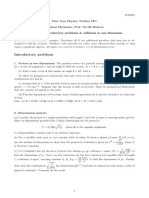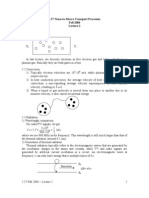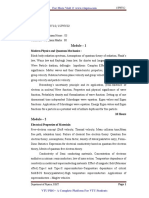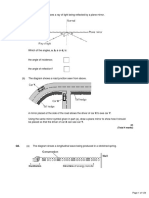Lab 1: SDOF Spring-Mass Systems: Objective
Lab 1: SDOF Spring-Mass Systems: Objective
Uploaded by
Tyranid hunterCopyright:
Available Formats
Lab 1: SDOF Spring-Mass Systems: Objective
Lab 1: SDOF Spring-Mass Systems: Objective
Uploaded by
Tyranid hunterOriginal Description:
Original Title
Copyright
Available Formats
Share this document
Did you find this document useful?
Is this content inappropriate?
Copyright:
Available Formats
Lab 1: SDOF Spring-Mass Systems: Objective
Lab 1: SDOF Spring-Mass Systems: Objective
Uploaded by
Tyranid hunterCopyright:
Available Formats
MECH 257: Mechanics of Vibrations
Lab 1: SDOF Spring-Mass Systems
Objective
The objective of this experiment is to verify our SDOF spring-mass model using an
actual spring of stiffness k connected to a known mass m. We will experimentally
determine the natural frequency n of vibration to compare with the theoretical value for
various masses.
Theory
As in class, we consider the SDOF spring-mass system shown below, where we define a
displacement coordinate x(t) referenced from the equilibrium position of the mass m.
The governing equation of motion can be derived from Newtons second law, where we
obtain (neglecting any energy dissipation, called damping)
m&x& + kx = 0.
(1)
The general solution to Eq. (1) is a sinusoidal function,
x(t ) = A1 cos(nt ) + A2 sin (nt )
x(t ) = A sin (nt + )
(2)
MECH 257: Mechanics of Vibrations
where
n =
k
m
(3)
is called the system natural frequency of vibration, A is the amplitude of
vibration, and is called the phase angle.
Procedure
1. You are given a spring. Using a static deflection test, determine the spring
constant k by completing the following table.
UNDEFLECTED SPRING LENGTH
l = ___________________________
Suspended Mass
m [kg]
Suspended Weight
W [N]
[m]
Spring Deflection
[m]
Spring Stiffness
k [N/m]
AVERAGE SPRING STIFFNESS
k = ___________________________
[N/m]
MECH 257: Mechanics of Vibrations
2. Using a stopwatch, time the period of five complete oscillations (i.e. the mass
starts in a low position, moves up to the high position and back a total of five
times) for several different masses. Complete the following table.
Mass
m [kg]
Period for
5 Complete
Oscillations
T5 [s]
Period for
One
Complete
Oscillation
T =T5 / 5 [s]
Experimental
Natural
Frequency
2
=
[rad/s]
T
Theoretical
Percent
Natural
Difference
[%]
Frequency
k
n =
[rad/s]
m
3. Now try including the effect of the spring mass ms, by modifying Eq. (3) as
n =
k
m + (ms / 3)
Determine the spring mass
ms = Ws / g = ___________________________
[kg]
and complete the following table by using the results from the previous table in
the first two columns.
MECH 257: Mechanics of Vibrations
Mass
m [kg]
4.
Experimental
Natural
Frequency
2
[rad/s]
=
T
Theoretical Natural
Frequency
k
n =
[rad/s]
m + (m s / 3)
Percent
Difference
[%]
Now repeat the experiment for the transverse vibration of an aluminum bar fixed
at one end with a mass m attached to the free end, having an equivalent spring
stiffness of
3EI Ebh3
keq = 3 =
l
4l 3
(4)
where I = bh3/12, E is the elastic modulus of the material, b is the bar thickness, h
is the bar height, and l is the bar length, so that if we include the mass of the bar,
n =
keq
m + (ms / 3)
Take E = 69109 N/m2 as the modulus of elasticity for the beam material, and
measure all other required dimensions.
(5)
MECH 257: Mechanics of Vibrations
Ebh3
keq =
= __________________________
3
4l
ms = Ws / g = ___________________________
Mass
m [kg]
Period for
5 Complete
Oscillations
T5 [s]
Period for
One
Complete
Oscillation
T =T5 / 5
[s]
Experimental
Natural
Frequency
2
=
[rad/s]
T
[N/m]
[kg]
Theoretical
Natural
Frequency
k eq
n =
m + (m s / 3)
[rad/s]
Percent
Difference
[%]
Questions
1. From your results, can the mass of the spring reasonably be neglected when
determining the system natural frequency? Why or why not?
2. Is there any way in which you could suggest to modify this experiment to obtain
more realistic results?
3. Is there any way in which you could suggest to modify our mathematical model to
better match our experimental results?
You might also like
- Problem Solutions Becker String TheoryDocument129 pagesProblem Solutions Becker String Theorybanedog100% (2)
- Shock Force (Second Edition) (10421658) PDFDocument111 pagesShock Force (Second Edition) (10421658) PDFTyranid hunterNo ratings yet
- Physics Formula Sheet PDFDocument4 pagesPhysics Formula Sheet PDFmd hasaanNo ratings yet
- 2014 ExercisesDocument8 pages2014 ExercisesElvir PecoNo ratings yet
- Lab8 Simple Harmonic (3)Document5 pagesLab8 Simple Harmonic (3)yugshah180No ratings yet
- Notes On Mechanical Vibrations: 1 Masses and Springs-The Linear OscillatorDocument10 pagesNotes On Mechanical Vibrations: 1 Masses and Springs-The Linear Oscillatoramlandas08No ratings yet
- Simple Harmonic Motion Lab: K M T and M KDocument2 pagesSimple Harmonic Motion Lab: K M T and M Knio tistaNo ratings yet
- Dynamics CourseworkDocument9 pagesDynamics CourseworkRodney MensahNo ratings yet
- Modal Analysis of Beams - An Experiment Symposium On Dynamic Problems of MechanicsDocument9 pagesModal Analysis of Beams - An Experiment Symposium On Dynamic Problems of MechanicsnizamshahrinNo ratings yet
- 5.6 Unforced Mechanical Vibrations: Simple Harmonic MotionDocument8 pages5.6 Unforced Mechanical Vibrations: Simple Harmonic MotionHaridev MoorthyNo ratings yet
- Introductory Problems: Problems I: Introductory Problems & Collisions in One DimensionDocument4 pagesIntroductory Problems: Problems I: Introductory Problems & Collisions in One DimensionDiego ForeroNo ratings yet
- Lecture 3 System ModelingDocument16 pagesLecture 3 System Modelinganon_412646200No ratings yet
- Structural Dynamics: Force DT MV DDocument12 pagesStructural Dynamics: Force DT MV DrajNo ratings yet
- Modeling Material Damping Properties in AnsysDocument16 pagesModeling Material Damping Properties in AnsysNono_geotec100% (1)
- Bazzucchi Campolmi ZattiDocument47 pagesBazzucchi Campolmi ZattiFilippoPippoCampolmiNo ratings yet
- Differential EquationDocument27 pagesDifferential EquationRubina ArifNo ratings yet
- Review eDocument5 pagesReview eKing OfheartsNo ratings yet
- MEN-351-criticl Speed-Manuscript 20181225Document8 pagesMEN-351-criticl Speed-Manuscript 20181225laura villarroelNo ratings yet
- Limitation Imposed On Structural DesignerDocument2 pagesLimitation Imposed On Structural DesignerdvarsastryNo ratings yet
- Newtonian Mechanics - Part 2: L Del Debbio, University of EdinburghDocument7 pagesNewtonian Mechanics - Part 2: L Del Debbio, University of Edinburghcharles luisNo ratings yet
- Mohamed Wael 191383Document9 pagesMohamed Wael 191383amr01212086953No ratings yet
- Home Work 5 - Chapter 5: SolutionsDocument6 pagesHome Work 5 - Chapter 5: SolutionssarahhNo ratings yet
- Mechanical VibrationsDocument12 pagesMechanical VibrationsDhiyanesh WaranNo ratings yet
- PHYSICS IMP QUESTION Unit-1&2Document8 pagesPHYSICS IMP QUESTION Unit-1&2pp2334966No ratings yet
- JEE_Main_2024_Solution_April_9_Shift_1_87ad5aaace2588ec18ddc7ec102f39bcDocument28 pagesJEE_Main_2024_Solution_April_9_Shift_1_87ad5aaace2588ec18ddc7ec102f39bcaryan55957No ratings yet
- Lab-3 (OL) Periodic and Simple Harmonic Motion - Using PhET SimulationDocument6 pagesLab-3 (OL) Periodic and Simple Harmonic Motion - Using PhET Simulationtanya desilvaNo ratings yet
- Lectures 23-24 Chapter 15 Fall 2009Document28 pagesLectures 23-24 Chapter 15 Fall 2009tewari_skNo ratings yet
- Phys130 EA02 Midterm SolutionDocument16 pagesPhys130 EA02 Midterm SolutionChristian MartinezNo ratings yet
- Chapter1 PDFDocument13 pagesChapter1 PDFnkoreisha7752No ratings yet
- HiwotDocument16 pagesHiwotFiker FikerwessenuNo ratings yet
- SHM ReviewDocument2 pagesSHM ReviewShabbir H. KhanNo ratings yet
- Midterm1 PracDocument3 pagesMidterm1 PracJames ScribdNo ratings yet
- Quantum Problems PDFDocument2 pagesQuantum Problems PDFphooolNo ratings yet
- Chapter 16Document43 pagesChapter 16German ToledoNo ratings yet
- Tutorial + Correction Mechanical Vibration Chapter 3Document15 pagesTutorial + Correction Mechanical Vibration Chapter 3Mohammed Al HelaylNo ratings yet
- Damping Lab 1Document60 pagesDamping Lab 1Robert Lau Yik SiangNo ratings yet
- TD BIT Mecanique vibratoire angDocument5 pagesTD BIT Mecanique vibratoire angsergenagalo03No ratings yet
- Module 3Document10 pagesModule 3Benson MataNo ratings yet
- Structural Mechanics Laboratory: Project ReportDocument10 pagesStructural Mechanics Laboratory: Project ReportJayanth KumarNo ratings yet
- MIT2 003SCF11 Pset9 SolDocument10 pagesMIT2 003SCF11 Pset9 SolDasaka BrahmendraNo ratings yet
- d1) 2DOF (Rev1)Document44 pagesd1) 2DOF (Rev1)chocsoftwareNo ratings yet
- The Atwood Machine: (Newton's Second Law and The Conservation of Energy)Document3 pagesThe Atwood Machine: (Newton's Second Law and The Conservation of Energy)Himanshu KrNo ratings yet
- Multiple Periodic Solutions To A Suspension Bridge Ordinary Differential EquationDocument17 pagesMultiple Periodic Solutions To A Suspension Bridge Ordinary Differential EquationImam MufidNo ratings yet
- Mathematical Methods of Physics - Fall 2010 - Dr. E.J. ZitaDocument6 pagesMathematical Methods of Physics - Fall 2010 - Dr. E.J. ZitaabiyyuNo ratings yet
- Coulomb Interaction: Auger Electron Is EjectedDocument10 pagesCoulomb Interaction: Auger Electron Is EjectedLuis Gutierrez MelgarejoNo ratings yet
- Dynamics Prob Set (Seph)Document23 pagesDynamics Prob Set (Seph)Rodge BalNo ratings yet
- Multiscale Splitting Method For The Boltzmann-Poisson Equation: Application To The Dynamics of ElectronsDocument14 pagesMultiscale Splitting Method For The Boltzmann-Poisson Equation: Application To The Dynamics of ElectronsLuis Alberto FuentesNo ratings yet
- Section1 10Document17 pagesSection1 10sonti11No ratings yet
- 2.57 Nano-to-Macro Transport Processes Fall 2004Document6 pages2.57 Nano-to-Macro Transport Processes Fall 2004captainhassNo ratings yet
- Basics of Vibration DynamicsDocument41 pagesBasics of Vibration DynamicshahahaNo ratings yet
- April 2009 FinalDocument10 pagesApril 2009 FinalAdalric LeungNo ratings yet
- Appendix D 2008Document14 pagesAppendix D 2008Daniel LiawNo ratings yet
- PPS Project ReportDocument7 pagesPPS Project ReportRITIK JAINNo ratings yet
- Harmonic Oscilator Lecture NotesDocument5 pagesHarmonic Oscilator Lecture Notesdanger99No ratings yet
- 2 Free Vibration: Any System Possessing Mass and Elasticity Is Capable of VibrationDocument11 pages2 Free Vibration: Any System Possessing Mass and Elasticity Is Capable of VibrationNumkang KangNo ratings yet
- Homework SHMDocument3 pagesHomework SHMuzair.abrar99No ratings yet
- Section 3.4 Newtonian MechanicsDocument7 pagesSection 3.4 Newtonian MechanicsWindu Nur MohamadNo ratings yet
- Assignment - 2 ME354ADocument4 pagesAssignment - 2 ME354Aharsh gargNo ratings yet
- ME312 Lab Manual 2021 - Cantilever BeamDocument7 pagesME312 Lab Manual 2021 - Cantilever BeamPranav BajajNo ratings yet
- Problems in Quantum Mechanics: Third EditionFrom EverandProblems in Quantum Mechanics: Third EditionRating: 3 out of 5 stars3/5 (2)
- Shock Force (Second Edition) (10421658) PDFDocument111 pagesShock Force (Second Edition) (10421658) PDFTyranid hunterNo ratings yet
- Make This The People of The Hills of EeeDocument2 pagesMake This The People of The Hills of EeeTyranid hunterNo ratings yet
- World DetailsDocument2 pagesWorld DetailsTyranid hunterNo ratings yet
- 2011 12 Exam ScheduleDocument6 pages2011 12 Exam ScheduleTyranid hunterNo ratings yet
- Physics of UltrasoundDocument11 pagesPhysics of Ultrasoundcasolli100% (1)
- 3 Chap Test-3Document2 pages3 Chap Test-3Duaa KhanNo ratings yet
- ASTRO1 PhysicsDocument2 pagesASTRO1 PhysicsbrianahdelacroixNo ratings yet
- TRS-398 Low X v1.06Document3 pagesTRS-398 Low X v1.06TarekShabaka100% (1)
- Building Defects Diagnosis by Infrared Thermography: Tommy Y. Lo and K.T.W. ChoiDocument5 pagesBuilding Defects Diagnosis by Infrared Thermography: Tommy Y. Lo and K.T.W. ChoiBarabingaNo ratings yet
- Engineering Physics 15phy12 NotesDocument131 pagesEngineering Physics 15phy12 NotesHarsha K J0% (1)
- 7 Atomic Structure: E N (Note: We Are Keeping All of Our Numbers X 10 Joules Just To Make The Graphing Easier.)Document4 pages7 Atomic Structure: E N (Note: We Are Keeping All of Our Numbers X 10 Joules Just To Make The Graphing Easier.)Vaughn MyersNo ratings yet
- JAFM - Volume 11 - Issue (Special Issue) - Pages 141-150Document10 pagesJAFM - Volume 11 - Issue (Special Issue) - Pages 141-150Fauzi Hussin LeoNo ratings yet
- NDT FormulaeDocument6 pagesNDT FormulaeTariqNo ratings yet
- Use of Gas Tables Permitted, Assume Suitable Value For Missing DataDocument2 pagesUse of Gas Tables Permitted, Assume Suitable Value For Missing DataVenkitaraj K PNo ratings yet
- Mechanical Vibration Ch-6Document34 pagesMechanical Vibration Ch-6Befikad BekeleNo ratings yet
- Physics of RadiationDocument8 pagesPhysics of Radiationalialahmedy24No ratings yet
- Airliquide- modeling for HD fillingDocument18 pagesAirliquide- modeling for HD fillingnikhilNo ratings yet
- Kat (Pat) - Viii Calss - WS - 1Document3 pagesKat (Pat) - Viii Calss - WS - 1Akshit MittalNo ratings yet
- Q2 M3 ScriptDocument2 pagesQ2 M3 ScriptKymbelle Paul SardidoNo ratings yet
- FYP Thesis - Optimization of Cooling Performance of A Micro-Channel Heat Sink - Khawaja Aqib AzizDocument50 pagesFYP Thesis - Optimization of Cooling Performance of A Micro-Channel Heat Sink - Khawaja Aqib Azizaqibaziz76100% (2)
- Module 2 - OCNDocument28 pagesModule 2 - OCNSudarshanNo ratings yet
- Major Losses ProblemsDocument5 pagesMajor Losses ProblemsartsmounaNo ratings yet
- Space Physics NotesDocument30 pagesSpace Physics Notesfgthy100% (1)
- Lorentz Transformation of Blackbody RadiationDocument3 pagesLorentz Transformation of Blackbody Radiationjcurol4No ratings yet
- Determination of The Resolving Power of A TelescopeDocument5 pagesDetermination of The Resolving Power of A TelescopePrashant KoreNo ratings yet
- General Familiarity With Other NDT Methods Module 1Document4 pagesGeneral Familiarity With Other NDT Methods Module 1mujjamilNo ratings yet
- HT - Conduction - by Kenil JaganiDocument5 pagesHT - Conduction - by Kenil JaganiDishant DhokiyaNo ratings yet
- P1 5 Waves Foundation QuestionsDocument124 pagesP1 5 Waves Foundation QuestionsjesudassajNo ratings yet
- Waves, Sound and Light: WorksheetDocument5 pagesWaves, Sound and Light: Worksheetapi-202182511No ratings yet
- Day 5Document31 pagesDay 5Abhiram SwarnaNo ratings yet
- Phy - G 11-CH-6Document17 pagesPhy - G 11-CH-6Metiku DigieNo ratings yet
- Menyuk 1988Document11 pagesMenyuk 1988yvelin yvelinNo ratings yet
- (Tijdeman, H) Sounc Waves in Cylindrical Tubes (1975)Document33 pages(Tijdeman, H) Sounc Waves in Cylindrical Tubes (1975)Louis LafeuilleNo ratings yet






























































































